THE LURE OF THE LOIRE: EXPLORING ITS CHATEAUX, GARDENS & SO MUCH MORE – PART ONE
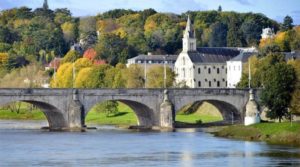
With an abundance of charming historic towns and villages, world famous vineyards, beautiful gardens, sweeping forests, great architectural monuments and majestic châteaux, the “Garden of France”, and “The Valley of Kings,” as the region is variously known, is listed as a UNESCO World Heritage Site, and a must-see for a memorable visit to France. As there are over 300 châteaux in the Loire Valley, around 100 of which are open to the public, it’s a region that needs more than a rushed day trip from Paris to do it justice. Here are some suggestions to help you plan a memorable visit to this special part of France.
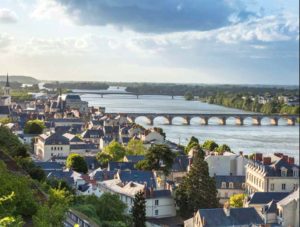
Over 1,000kms long, the river Loire is the longest in France, passing through some of the most fertile land in the country. By 600BC the river was a key trading route, familiar to the ancient Celts who traded along its length using pack horses to link its trade in the metals of the geological Armorican Massif with Phoenicia and Ancient Greece, via Lyon on the river Rhône.
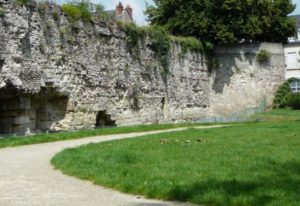
Following the Roman conquest by Julius Caesar in 56BC, new settlers established vineyards and started producing wines. From the early medieval to the late Renaissance periods, the Loire Valley became a kind of threshold, a dividing point between the north and south of the country, and for some time a fault line between rival factions and their armies.

The first châteaux in the area were therefore feudal fortresses that withstood waves of invaders from the 8th century forces of the Umayyad caliphate (the conquerors of Hispania) to 9th century marauding Vikings. During the Hundred Years War, the Loire Valley was a battleground between the French and the English. By this time the Valley was thick with defences, and every town was a fortress.
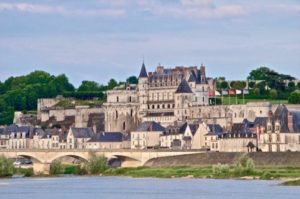
When the Hundred Years War ended in 1453, the many châteaux no longer needed to be defensive fortresses, and gradually became converted into palaces of relaxation and pleasure. Louis XI made his Touraine château his permanent residence in 1444, and it remained a popular residence for the kings of France and the royal court even after the court moved back to Paris in the next century. Following the king’s move, firstly to Tours, then Blois and later Amboise, these all became the preferred locations of the French royal court, many of whom bought dilapidated châteaux built by the medieval Counts of Blois and of Anjou, and had them reconstructed in the latest Italianate fashion. Many are so extravagant that the owners were obviously trying to outdo each other.
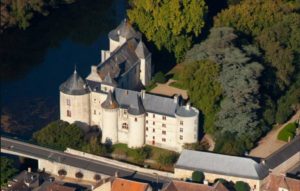
Others though, such as the Château de la Guerche, south of Tours or the Château du Plessis-Bourré, north of Angers, have retained their wide moats, drawbridges and multiple gatehouses.
250kms south west of Paris, it takes about 2 1/2hrs to drive down to the Loire Valley. Alternatively, there are trains from Paris to parts of the Loire. For example, there’s a TGV train to Tours from Gare Montparnasse; there’s a regular SNCF train to Blois-Chambord station from Gare Austerlitz and there are trains to Angers from Gare Austerlitz or Gare de l’Est.
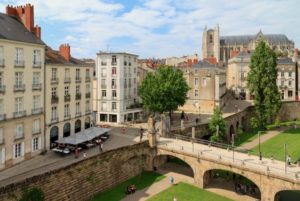
On our most recent Loire trip, we took the TGV from Montparnasse down to Nantes, which is an attractive, fascinating town full of history and great attractions—well worth a day or two—from where we rented a car to explore the area, and especially because the châteaux in particular are often some distance from the nearest town, and even access into the grounds of many châteaux is usually some distance to walk from the road.
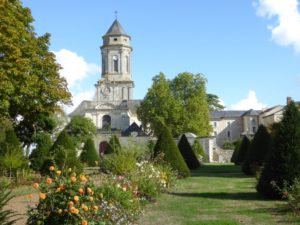
The area covering the World Heritage listing stretches some 280 kms, from Chalonnes-sur-Loire, about 27kms S.W. of Angers, across to Sully-sur-Loire near the town of Gien, approx. 45kms S.E. of Orleans. In this area alone there are a huge number of sites that welcome visitors, enough to keep you busy for weeks, ranging from grand, former royal châteaux and smaller, family châteaux, gardens, museums, towns, monuments and beautiful churches, all of historic and architectural significance.
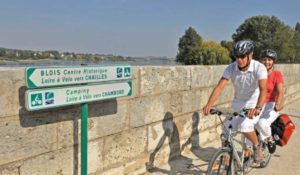
Aside from driving or taking an organised tour, there are other ways to explore the Loire Valley, including well-marked walking and hiking paths and signposted cycling trails called the ‘Loire à Vélo’—the cycle paths run for a staggering 800km—as well as fantastic hot air balloon trips that take you over the most spectacular sights.
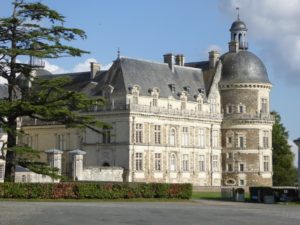
Most of the châteaux are privately owned and operated, while some are managed by the Centre des Monuments Nationaux, a public institution under the Ministry of Culture and Communication, created in 1914. As a result, there is little co-ordination of ticketing such that you cannot purchase a ticket or pass that covers multiple properties. However, some have grouped together to offer a pass that covers those within the group, and some have discounts for repeat visits after the first purchase. Before visiting, always check opening times, especially as many don’t open every day, as well as other conditions, as some operate a timed tour system only that does not allow access except on the tour.
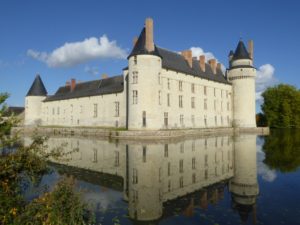
The cost of visiting châteaux can start to add up, with adult admissions ranging from a low of 7€ to 15€, and as there’s not much by way of discounts, combination tickets can help a little. The various Tourist Bureaux are the places to visit to find out what passes or combinations are available in their particular area. The Tours Tourism Bureau sells tickets at a small discount for a number of individual châteaux, and the Amboise Tourist Information Office offers a variety of passes that provide modest discounts on admission fees. Passes can be purchased from 2 to 9 châteaux. In addition, some son-et-lumière (Sound & Light Show) tickets can be bought in combination with château admission.

The Châteaux de la Loire association consists of around 80 monuments in the Loire Valley, between Nantes and Gien. Their goal is to promote these attractions to the public, by combining tourism and culture. The châteaux of Amboise and Chambord offer a “trio” pass that includes both of these plus the Château de Clos-Lucé where Leonardo da Vinci lived and died. This package is sold at the ticket booths of the three monuments.
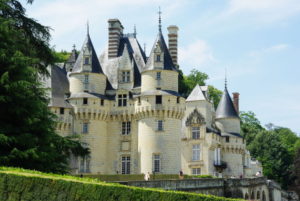
Owing to the size of many châteaux, trying to fit in too many in a day is very tiring and mentally exhausting. I suggest you plan your visits to the larger ones in the mornings, leaving the afternoons to explore some of the smaller châteaux—and often just as interesting as the enormous ones—perhaps explore some of the delightful small towns or villages, or for a change of scene, one of the region’s many fine vineyards. There are also lots of lovely spots along the river to enjoy a picnic lunch made up of local goodies purchased in any of the towns.
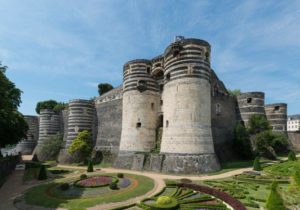
Heading east along the Valley, the number of châteaux becomes thick on the ground from Angers, and especially Saumur onwards.
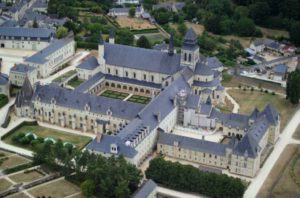
One outstanding site to visit is the Royal Abbey of Fontevraud, about 15kms slightly S.E. of Saumur. Founded in 1101, in its heyday it was Europe’s largest monastic complex, covering over 14 hectares. It’s a listed UNSCO World Heritage Site, and its religious buildings, cloisters and dormitories have all been meticulously restored, but still leaving some traces of the Abbey’s service as a notorious prison from 1804 to 1963, set up by Napoleon.
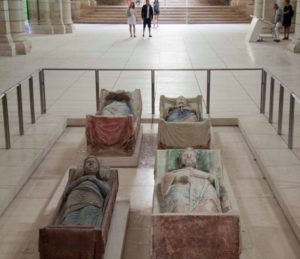
The English Plantagenet tombs of Henry II, his wife Eleanor of Aquitaine and their son Richard the Lionheart are in the nave of the main abbey. On 05 December 2020, a new modern art museum opened in the former coach house and stables housing paintings and sculptures from the 19th and 20th centuries. For a unique place to stay, there’s now a four star hotel installed in the Saint-Lazare priory, one of four former priories on the site. Another drawcard is that the hotel’s restaurant was awarded a Michelin star in 2017.

The picturesque town of Saumur, which straddles the Loire, has many great attractions, including the Château de Saumur, which dominates the river, and the troglodyte villages of Souzay-Champigny and Louresse-Rocheminier. With abundant fresh fish, mushroom caves and kilometres of vineyards, it’s all about gastronomic delights as well as cultural pursuits in this part of the Loire.

Three kms. out of Saumur, in the town of Saint-Hilaire-Saint-Florent, you can visit the famous Cadre Noir Cavalry School of the French Institute of Horses and the French National Horse-Riding School that trains horses for national and international competitions. You can visit the horses and see one of the spectacular equestrian shows in the arena.
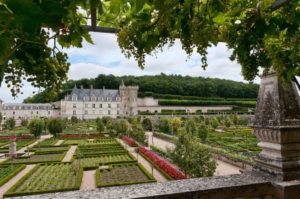
Leaving Saumur and continuing east is one of the most famous of the Valley’s châteaux, the elegant Château de Villandry, situated right in the heart of the ‘Garden of France’, 16kms from Tours. Not only is the 15th century château itself a jewel of Renaissance architecture, but it has one of the most outstanding Renaissance-style formal gardens in France—an absolute must-see for garden lovers. The estate is divided into six gardens, each with its own theme.
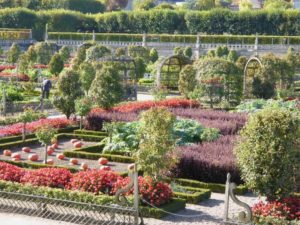
Many people regard the kitchen garden as the one that steals the show, with nine identical squares, each one bearing a different motif and filled with vibrant colourful vegetables such as purple cabbages, jade green carrot tops and blue leeks. The gardens are open almost all year round, and tickets can be purchased for château plus gardens, or just for the gardens only.

The birthplace of the great writer Balzac, the charming Gallo-Roman town of Tours is usually referred to as the gateway to the Loire Valley, and is one of the most picturesque and vibrant destinations of the region. It lies at the confluence of two rivers: the Loire and the Cher, and much of the town’s wealth was due to being able to export locally manufactured goods, especially high-value textiles, along these two waterways.
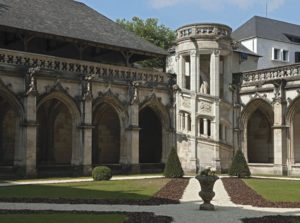
Known for its gastronomy, Tours has no lack of good restaurants and excellent hotels, making it a great base to explore the area. Its narrow, cobbled streets, half-timbered houses, particularly on Place Plumereau with its many convivial little terraces, and the monumental Saint-Gatien cathedral, all give the town a charming medieval air, and the lovely historic centre has a UNESCO World Heritage listing. Don’t miss the Halles de Tours, where you can buy local gourmet goodies, the Renaissance architecture of the Fine Arts Museum and the Hotel Gouin, as well as the Château de Tours, the flamboyant façades and ceiling of ‘la Psalettte’ cloister and Saint Martin’s Basilica.
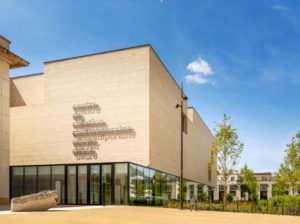
Check out too the new Centre de Création Contemporaine Olivier Debré which was due to open in January this year. The city also has some notable gardens, such as the Prebendes d’Oe, the botanic garden, and the Plaine de la Gloriette park. A pleasant way to relax would be to take a short boat trip on the river, and later enjoy the son et lumière show projected onto the façade of the Fine Art Museum each evening during the summer.

Not only is Tours a lovely town in which to spend time, it also has many of the iconic châteaux in relatively close proximity. It’s difficult to reduce the vast list of châteaux to a “best of”, as that’s such a subjective assessment. However, there are a number that are universally agreed to be the crème-de-la-crème.
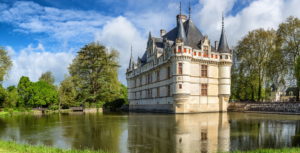
A personal favourite of ours is the Château d’Azay-le-Rideau. Built on a small inland in the river Indre, this is one of the loveliest and most visited château in the Valley. Built in the Renaissance style during the reign of Francois l on the site of a small fortified château, its turreted façade is reflected in the still waters of the river, making time itself appear to stand still. All rooms in the château are furnished, which is not true of all the chateaux of the Valley. The delightful gardens are known for the examples of trees from around the world, and there’s a stunning son-et-lumière show, considered the best in the region, during July and August.
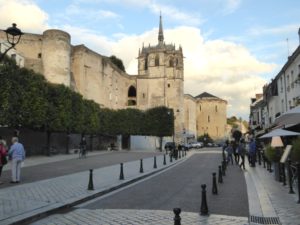
About 24kms east of Tours lies the Château d’Amboise. You can’t miss it as you approach the town of Amboise, due to its dominating position looming on a promontory high above the river Loire. It was an obvious choice of location for the original fortress. It was seized by Charles Vll in the mid 1400s, and was a royal residence up until the Revolution.
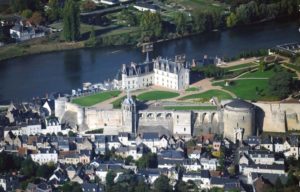
It was restored to the monarchy under Louis-Philippe, but was confiscated by the government at the time of his abdication. Although it seems large, the château today is in fact only about a fifth of its original size.
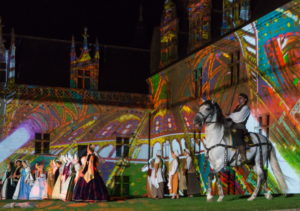
During peak season the château puts on a spectacular, and very polished, son-et-lumière show, titled ‘At the Court of Francois l’ with hundreds (yes, hundreds!) of local volunteers bringing their history to life in all its pageantry and splendour. Note though that as with other similar outdoor events, it can be cancelled because of the weather.
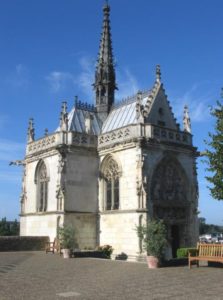
One of the main claims to fame for the Château d’Amboise is that in 1516, the arts-loving Francois l invited Leonardo da Vinci to stay at the delightful Château du Clos-Lucé nearby, with a promise of a pension, the only condition being that he devote some of his time to intellectual conversation and companionship with the king.
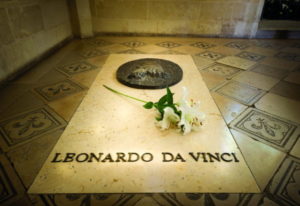
Leonardo crossed the Alps on a mule, carrying some of his precious artwork, including the Mona Lisa, which explains why it now hangs in the Louvre and not Rome. His remains now lie within the Chapelle Saint-Hubert, located in the grounds just before the entrance to the Château d’Amboise.
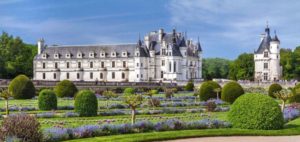
The Château de Chenonceau is the most visited, recognisable and photographed château of the Loire Valley. It lies S.E. from Tours, a little over 30kms by road. Handed over to the king in lieu of huge debts, Henri ll installed his mistress Diane de Poitiers there, and it was she who added the bridge over the Cher, as well as the beautiful gardens. It’s said that there are over 130,000 bedded plants used in summer. The gardens are illuminated at night on weekends in June and every evening during July and August from 21.30hrs.
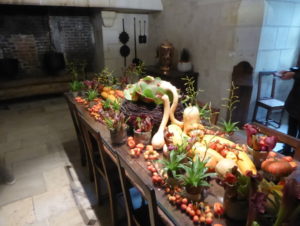
The rooms of the château are well furnished and there are a number of fine paintings by Rubens, Tintoretto and others, but don’t miss either the lovely small chapel, or the fantastic kitchens where there is a small landing platform beneath the vaulted cellars where supplies would be transferred from river boats to the kitchen servants. During WW1 Chenonceau was used as a military hospital, and in WW2 it was used as a route by the Résistance to enter Vichy (free) France from German-occupied France, as the river Cher was the demarcation line between the two. As a suggestion, plan to visit Chenonceau in the morning as it becomes extremely busy from mid-afternoon in high season.

Along with Chenonceau, perhaps the most famous château in the Loire would have be Chambord, which lies about 15kms east of the town of Blois. This vast Renaissance extravagance was started by Francois l in the early 16th century as a hunting lodge (yes, seriously!), and now has over 400 rooms, 365 fireplaces and 84 staircases, plus a stables for 12,000 horses. The château was only used for around 2 months a year during Francois’ reign. The estate is surrounded by a wall of 32kms, and although you can cycle or walk the grounds, as the park is so vast, even shorter walks can take over an hour, so consider taking a horse-drawn carriage ride from the stables, where during the summer months, there is an equestrian show.
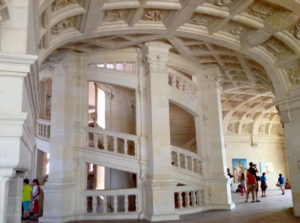
Aside from its sheer size, the most remarkable feature of Chambord is the famous double helix spiral staircase, said to have been thought up by Leonardo da Vinci when he was living at the Château du Clos-Lucé. Don’t miss going up onto the château’s roof, where you’ll have the most wonderful view of the vast park and ornamental lake, where you can hire small row-boats. The gardens have recently been restored to their original 18th century design. Each evening in July and August from 10.00pm to midnight the château façade is lit up in a way that blends the building with the forest via a son-et-lumière show.
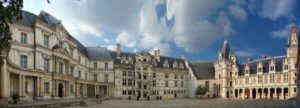
At the top of the town of Blois on the edge of a large square sits its château, formally called the Château Royal de Blois. It’s a brilliant illustration of the evolution of the French architecture of the Middle Ages up to the 17th century. Various kings, from Louis Xll, who built the oldest part, which as his residence, became the political capital of the kingdom, to Francois l, who added the Renaissance wing with its unique open circular staircase.
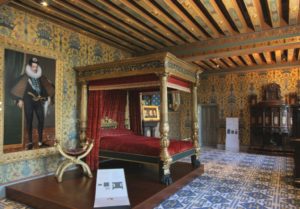
The staterooms have been beautifully restored, the first of which, dating from 1214, will take your breath away. As with so many other châteaux, Blois features its own son-et-lumière, which is well worth waiting around for. It takes place in the courtyard on summer evenings, and is the expected melodramatic historical narrative, backed by a light show and classical music.

Below the château is the lively old town with narrow streets and ancient buildings. Founded by the Romans, who made it a fortified castrum, Blois eventually became a royal town, and much of its architecture reflects the 16th century, though there are numerous buildings dating back to the 12th century. There are many impressive late Gothic and Renaissance buildings such as the palace of the Archbishop, surrounded by terraced gardens close to the river. There’s a 10th century cathedral, and various other religious buildings including the 13th century church of Saint-Nicholas on the site of a 9th century Benedictine abbey, and a 13th century Couvent es Jacobins, now the Museum of Natural History. There are many traditional restaurants specialising in local cuisine, including snails, duck sausage, beef, rabbit, and duck dishes, all to be enjoyed by classic Loire wines.
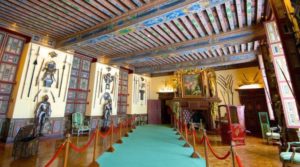
About 12kms south of Blois lies the beautiful Château de Cheverny. It’s not one of the biggest, yet it’s one of the best preserved châteaux in the entire country, with very fine interiors, a lovely garden, and has a famous pack of over 100 hunting dogs. If you visit the kennels around 11.30am you may be able to watch feeding time.
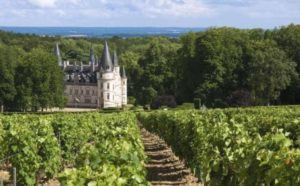
The Loire Valley has several distinct wine regions, each with its own characteristic grapes and over 85 appellations. From Nantes to Sancerre, the Loire is said to be the longest wine route in France, with the region’s vineyards an integral part of the Valley’s UNESCO World Heritage listing. Hidden behind each renowned wine district is a famous Loire château such as Chenonceau, Chambord, Brissac, Saumur and Chinon.
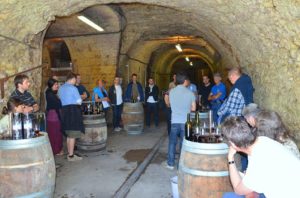
More than 1,000 vineyards are open to the public, including 400 specially accredited wine cellars, where you can meet the winemakers and taste their wines. Many have massive underground wine cellars and offer wine tasting walks in the vineyards, and some have accommodation available. Note that the Château de Chenonceau offers wine tastings at night.
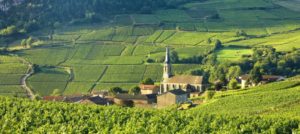
Taking a look at the vineyard areas of the Loire Valley, start on the western side, at the Pays Nantais near the city of Nantes, which has been producing wine since the Roman era, and is known chiefly for Muscadet. This crisp, aromatic, dry white wine is the largest white wine appellation in France. Heading east, the Anjou area is known for its reds made mostly from Cabernet Franc, Cabernet Sauvignon and Gamay grapes, while the whites are from Chenin, Sauvignon and Chardonnay grapes. Next is the Saumur area, famous for its Chenin Blanc wines, which perfectly accompany local white fish.

Do sample some Roquefort, a sheep’s milk cheese, and the outstanding local almost blue-grey Valençay or Selles-sur-Cher goats’ milk cheeses, and fresh local fruit. Saumur also produces a highly regarded sparkling wine.
The adjacent Touraine region is famous for numerous things. The French King, Charles VII received Joan of Arc at the Royal Fortress of Chinon, and the writer, physician and classical scholar François Rabelais was born here around 1483 (the exact year isn’t known).

The architecture and landscape of Chinon is a great drawcard for visitors, and of course, its vineyards which produce the famous Vouvray wines made from Chenin Blanc and Chinon, and Bourgeueil from Cabernet Franc.

If you visit the Cave de Vouvray, 10kms east of Tours, you can take a guided tour deep into the troglodyte cellars to learn how the region’s famous still and sparkling wine is made.
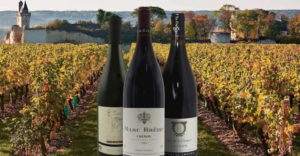
The Touraine appellation also includes excellent examples of Sauvignon Blanc, Gamay and Malbec (locally known as côt). The reds and rosé are mostly from Cabernet Franc, which pair very well with richer foods such as braised beef or game, mushrooms and suchlike. The exceptional whites from Chenin grapes go beautifully with fish and shellfish.

The Centre-Loire, as its name implies, is the exact geographic centre of France, and grapes have been grown here for at least 2,000 years. It’s the original home of Sauvignon Blanc, Sancerre and Pouilly-Fumé, which sets the international standard for these grapes. The area also produces excellent reds and rosé from Pinot Noir in Sancerre, Menetou-Salon and Châteaumeillant.
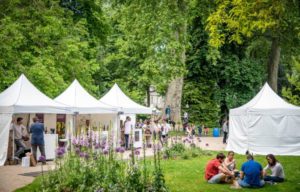
If you’re planning a trip to the Loire during May, head to the small city of Tours, which holds a ‘Vitiloire in Tours’ festival around 27-28th May. 150 or so enthusiastic winery owners from the Loire vineyards, flanked by a number of local chefs, take possession of the town centre. There are tastings of the local wines and food from the vicinity, as well as talks, food workshops and wine bar visits.
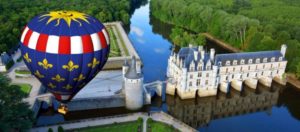
The Loire Valley is such a rewarding destination, with a great variety of stunning chateaux, beautiful gardens, first class wineries and attractive towns. It’s easy to get to, easy to navigate and as a result, some sites can become quite crowded, so plan your route accordingly. Because so much of interest is concentrated into the Valley, it’s tempting to try and see it all. But don’t be too ambitious—it’s the perfect excuse to return and explore some more delights the next time.
There are far too many beautiful and fascinating châteaux in the Loire for just this story, so next time, I’ll devote a post to a selection of those. Do let me know if you’d like to plan a Loire Valley trip as I may well have some useful suggestions.
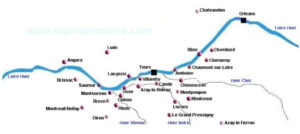


I’m assuming it’s Graham and you on the bicycle?
Oh yes absolutely–you know us and bicycles…!!
Thank you Cheryl for the “Lure of Loire Valley”. The descriptions and photos brought back lovely memories for us. We had two weeks in a private Chateau near Samur in 2012. We did ride bikes along the banks of the river, and then into town for coffee. Visited chateaux, tasted some marvellous wines visited caves and as we knew the owners of the chateau we were included in a marvellous five course lunch where some spoke French, some spoke English, but everyone knew how to laugh and sing. What a stunning part of France with amazing history.
Ah yes, I remember when you did that. What a fantastic experience with wonderful memories for you, so I’m glad that the blog brought some of that back to enjoy now, especially as armchair travel is as close as we’ll get for a while longer!
Best regards,
Cheryl
Ah yes, I remember when you did that. What a fantastic experience with wonderful memories for you, so I’m glad that the blog brought some of that back to enjoy now, especially as armchair travel is as close as we’ll get for a while longer!
Best regards,
Cheryl